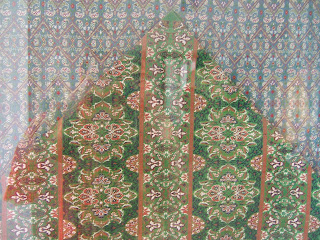 |
| The Azadi (Freedom) Tower, formerly known as Shahyad Aryamehr or King memorial tower |
It is funny how much time has elapsed between my last post on the first trip to Iran and this and how the 'second instalment' was never published, even if it is there, almost ready and will probably follow this one.
While that one focuses on a particular object (the janamaz I had made for my mother in law, who recently passed away) and explains the reasons behind the title of the post, this post will mainly show some of the photographs, taken in August 2012 whilst in Iran.
 |
| Drinking espresso coffee and sour cherry juice in an 'Art' Cafe in Teheran, one of the many cafes where students and couples can go and meet freely without nobody bothering them. |
In this increasing tense international climate I think it's important to show a more realistic and balanced image of the country (even if it is only just glimpses!) and how ordinary people are resorting to creativity in order to gain precious bits of personal freedom. Due to their history, this is an art in which all Iranians seem to be very skilled.
Iranians are proud of their heritage and with the future looking more and more uncertain, they prefer to look back to the past to reinforce their sense of identity and find the strength to carry on with their lives in the face of difficult times.
But what past? Where do you draw the line? Some prefer to look back to the very ancient past, some to the more recent one, especially the younger generations who haven't experienced personally the previous regime. Some regret the ' Arab invasion' but at the same time do not want to reject the whole Islamic culture, and most do prefer a 'middle way' if they can find one (Where does all that fundamentalism come from? I fail to see any trace of it among ordinary people, they seem a rather accommodating and inclusive lot!).
I am by no means qualified to even try and find an answer, I can only share this more than legitimate question, and hope that Iranians will rather find a way and a reason to look to the future. The cry for social justice and technological progress should go hand in hand with the quest for personal and political freedom.
Not that the West has much to teach in that respect!
On the way to Kashan
 |
| Service area on the way to Kashan |
 |
| Main entrance to the Bagh-e-Fin in Kashan, a traditional garden, whose origins go back to the Safavid period. |
In this wonderful garden in the city of Kashan, whose main entrance is shown above, there are two main building complexes, one going back to the Safavid dynasty and its main representative Shah Abbas, and the other to the Qajar dynasty. The garden is famous also for being the set of the murder of Amir Kabir the Qajarid chancellor, perpetrated by an assassin hired by the king Nasareddin Shah himself in 1852 (apparently the controversial chancellor was 'too advanced' for the king's liking)
http://en.wikipedia.org/wiki/Amir_Kabir.
He is now regarded as a symbol and a national hero.
 |
| Reconstruction of the murder of Amir Kabir with original objects on display , inside the bath house (hummam), next to the actual room where the murder was committed. |

 |
| Channel with fountains |
The garden also houses several pools, and a bathhouse (hummam) which take advantage of a sophisticated underground water system that carries water from some nearby mountains to a reservoir and then inside the garden through visible channels and with a pressure sufficient for fountains to spring.
 |
| One of the pools |
 |
| One of the rooms of the Hummum |
Even though this year we had a little bit more time to go and see things (as opposed to time devoted to family commitments), it was still very limited and this trip to Kashan (which included a visit to Qom on the same day!) didn't allow us to explore the place in full. Kashan is also renowned for many other fine examples of traditional Persian architecture
http://en.wikipedia.org/wiki/Kashan and last but not least is an important textile and carpet centre. With its carpets being among the most prized of the whole Iran.
 |
| Model of a traditional loom |
 |
| Some examples of traditional weaves, patterns and design |
Unfortunately this shows only fragments of an immensely rich textile tradition. Some of the patterns can be seen on the decoration of the ceiling, as it often happens that they can be used interchangeably in both textiles and architecture (and I suspect in other materials/ techinques throughout the decorative and applied arts)
 |
Ceiling showing details of the Gol-va Morgh (Flower and Bird) design, one of the most popular and beloved Persian patterns, frequently used as a decorative motif on carpets.
|
 |
| Detail of the Gol-va-Morgh pattern on a tablecloth |
 |
| Tablecloth featuring the gol-va- morgh pattern |
The same motif can be seen above in one of the very few pieces of textiles I could lay my hands on, a lovely tablecloth that I managed to buy at the last minute!
We did have some time though for a ten minute ride on a horse-driven cart around the compound, with the horse engaging in a whimsical race against a bike in front of him
Which the girls enjoyed thoroughly!
 |
| Sara with cousins Maryam and Mobina |
 |
| The 'buggy' or doroshkeh decorated with some Qajari imagery |




















